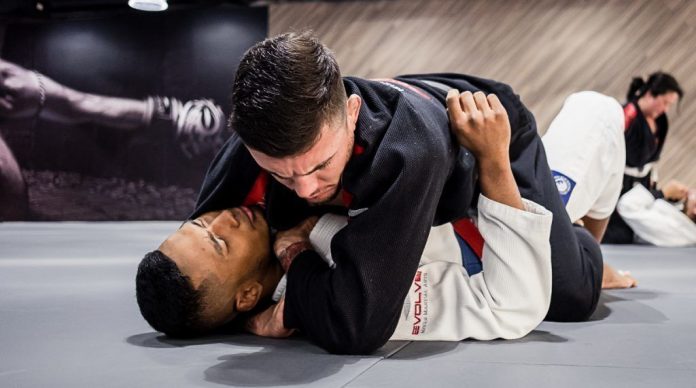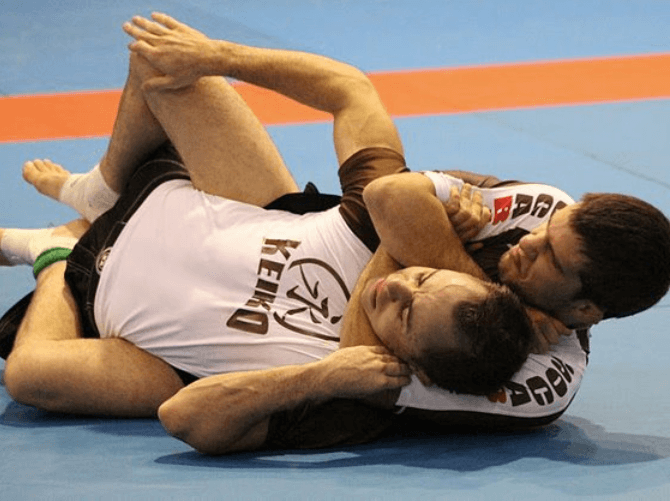
Brazilian Jiu-Jitsu is high-level problem solving under extreme stress. For me, Joe Rogan nailed it with this definition. What need to be understood is that this goes both ways. Durig a BJJ roll or a march, both partners are trying to solve a puzzle. One is looking at the problem defensively, while the other is looking to attack. Conversely, one needs to break through the opponent’s defense, and the other to escape and turn the tables. In attacking terms, BJJ submissions are the best way to finish a match, obviously. However, getting them against resisting opponents is no walk in the park.
BJJ is a game of imposing your will on a resisting opponent’s body. To do so you must find a way to break their resistance in order to apply a technique. An opponent who is stronger or more technical, even when caught in a bad spot, is going to stay calm and defend. The end result is going to be muscling out (the stronger ones) or time their escape perfectly (the more advanced ones). In order to be successful in your attack, you need to apply it when you wish. If you attack on terms created by your opponent you’ll most likely fail. So as opposed to just reacting to their defense, you must direct multiple threats towards them.
Principles Of Submission Hunting
Let’s use a simple example to paint a picture. Let’s say you keep going for a guillotine choke from a front headlock position. All the while your opponent is turtled up and has a good wide base. Even more so, they’re defending with both arms, hiding the neck in the process. If you keep forcing a guillotine you’ll most likely burn out trying to open them up and get that choke at all costs.
Everything You Need To Know About The Guillotine Choke: https://bjj-world.com/guillotine-choke-basics-bjj-submission/
However, if you threaten to transition to the back, attacking their turtle position from a different angle, you will elicit a different defense. Their consequent response will, in turn, open up the neck for your original guillotine attack.
In JiuJitsu there are four main ways to make your opponent react to you. you need to understand how to use them in unison when your hunting for BJJ submissions. After blue belt single submission attacks are rarely going to work. Yneedll nee to start chaining your BJJ submission in a system so that you can keep the threat level high. Here’s how to do it:
Kuzushi & Pressure
In Judo “Kuzushi” stands for disbalance. An opponent out of balance is always more open to attacks. They have the choice to let you come on top or to recover balance. In order to recover balance, the need to post a limb and push back against the force causing them to lose their balance. This is how you create a perfect opening for sneaking in BJJ submissions.
Another major factor that precedes BJJ submissions themselves, is pressure. When not addressed, the pressure will drain your opponent of their stamina. The opponent has to create space either by pushing (bad) or framing, bridging and hip escaping. All of these actions expose a limb or their neck to your submission attacks.
Submission Options
The threat of a joint lock blocks your opponent from moving in one direction and gradually forces him into the opposite direction.The opponent has the choice between going in the direction of the force or possibly injuring a limb. When looking to set up an armbar, for example, it’s always good to start trying to get a Kimura first, if you’re on top.
The choke is the king of the BJJ submissions. While a lock can be ignored at the price of possible injury, a properly executed choke has to be addressed. The opponent has the choice between defending their neck or passing out. When they look to defend, all the previously mentioned options (armbar, Kimura and other locks) open up. You just need to keep looking and do not be stubborn with any one move.
How to Attack BJJ Submissions
When fighting in a tournament, where time and points act as an external oppressor, the threat of a sweep or takedown can be largely ignored. This is usually based on your game plan and the duration of the match. Worst case scenario, you’ll only lose position.
Pressure can be also ignored for a good amount of time until you are completely drained. Of curse, handling pressure in the absolute division might not be your best competition strategy.
Which brings us to BJJ submissions. With a joint lock, you still have the ‘choice’ of risking your limb and maybe squeezing out a points victory (granted, at the greatest of costs). However, a properly executed choke is the only threat were all choice is taken away. If you decide to do anything but tap (and early, at that) when caught in a mechanically sound choke, you’ll sleep. There’s no going around it.
In a perfect scenario, you’d get on the mat and choke your opponent right away. However, perfection is a fleeting thing that’s rarely (if ever) attainable, so you’ll have to develop a more realistic strategy.
A Very Tight And Powerful BJJ Submission – The Calf Slicer
Applying Combinations In Competition
When a match starts, you gauge your opponent for a few moments and then manage to hit a takedown. After a short scramble, you land in top side control. That’s the principle of Kuzushi taken care of. From there it’s pressure, pressure, pressure. Pressure is going to take you to the mount, where you hunt for an armbar. Your opponent, however, is experienced in recognizing the armbar. In defense, they and turn at the right moment, managing to get you on your back. That’s when you, as the grappler who’s applying the concept of stringing BJJ submissions together go for the ultimate finish by wrapping a triangle choke. This transitional attack results in the inevitable tap or nap!
Another version, for the more advanced grapplers out there, would be the concept of using a submission threat, one of lesser consequences, as bait ot set up on of the higher ranked threats.
Let’s say you’re on the bottom and have managed to get a single leg X guard. You’re aware that your opponent has an outstanding base. After all, you’ve spent half the match trying to sweep from your open guard anyway.
Once you got that single X perfectly wrapped, you go all out for a spiral sweep. You might even overreach, which will cause your opponent to use all his balancing talent to stay upright. What you managed to accomplish though, by utilizing Kuzushi, is to open up the heel of the leg you have wrapped in the single leg X. This sets you up for a heel hook or a toehold, depending on the rules.
Approach BJJ as the art of deception and you’re submission rate is going to sky-rocket. Use the submission combination system to constantly keep your opponent guessing, while you tap them at will.


![Darce Choke Encyclopedia – Origins, Mechanics and Variations [2025] BJJ, choke, Brabo, BJJ Darce Choke, D'arce Choke, Darce BJJ Choke](https://bjj-world.com/wp-content/uploads/2017/11/JungPoirierLeeYahoo-218x150.jpg)











![Countering with Crab Ride Anthony Budion DVD Review [2025] Countering with Crab Ride Anthony Budion DVD Review](https://bjj-world.com/wp-content/uploads/2025/03/countering-with-crab-ride-anthony-budion-dvd-review-218x150.png)
![Closet Closed Guard Craig Jones DVD Review [2025] Closet Closed Guard Craig Jones DVD Review](https://bjj-world.com/wp-content/uploads/2025/03/closet-closed-guard-craig-jones-dvd-review-218x150.png)
![Xanadu Back Takes Levi Jones-Leary DVD Review [2025] Xanadu Back Takes Levi Jones-Leary DVD Review](https://bjj-world.com/wp-content/uploads/2025/03/xanadu-back-takes-levi-jones-leary-dvd-review-218x150.png)

![No-Gi Grapplers Guide To Front Headlock Joel Bane DVD Review [2025] No-Gi Grapplers Guide To Front Headlock Joel Bane DVD Review](https://bjj-world.com/wp-content/uploads/2025/03/no-gi-front-headlock-joel-bane-dvd-review-218x150.png)

![Creating Back Exposure Luke Griffith DVD Review [2025] Creating Back Exposure Luke Griffith DVD Review](https://bjj-world.com/wp-content/uploads/2025/01/creating-back-exposure-luke-griffith-dvd-review-324x235.png)






![10th Planet Leg Locks Jeremiah Vance DVD Review [2025] 10th Planet Leg Locks Jeremiah Vance DVD Review](https://bjj-world.com/wp-content/uploads/2025/01/10th-planet-leg-locks-jeremiah-vance-dvd-review-100x70.png)
![Countering with Crab Ride Anthony Budion DVD Review [2025] Countering with Crab Ride Anthony Budion DVD Review](https://bjj-world.com/wp-content/uploads/2025/03/countering-with-crab-ride-anthony-budion-dvd-review-100x70.png)
![Intro To Hip Mobility for Guard Players Joshua Presley DVD Review [2024] Intro To Hip Mobility for Guard Players Joshua Presley DVD Review](https://bjj-world.com/wp-content/uploads/2024/09/hip-mobility-for-guard-joshua-presley-dvd-review-100x70.png)
![Miko Hytonen Lapel Chokes From Everywhere DVD Review [2024] Miko Hytonen Lapel Chokes From Everywhere DVD Review](https://bjj-world.com/wp-content/uploads/2024/10/miko-hytonen-lapel-chokes-from-everywhere-dvd-review-100x70.png)

![Master Scissor Sweep Ryan Scialoia DVD Review [2025] Master Scissor Sweep Ryan Scialoia DVD Review](https://bjj-world.com/wp-content/uploads/2024/12/scissor-sweep-ryan-scialoia-dvd-review-100x70.png)


![Basic Closed Guard Jasmine Rocha DVD Review [2024] Basic Closed Guard Jasmine Rocha DVD Review](https://bjj-world.com/wp-content/uploads/2024/11/basic-closed-guard-jasmine-rocha-dvd-review-100x70.png)
![Dynamic De La Riva Guard Otavio Sousa DVD Review [2025] Dynamic De La Riva Guard Otavio Sousa DVD Review](https://bjj-world.com/wp-content/uploads/2025/02/dynamic-de-la-riva-guard-otavio-sousa-dvd-review-100x70.png)
![No-Gi Grapplers Guide To Front Headlock Joel Bane DVD Review [2025] No-Gi Grapplers Guide To Front Headlock Joel Bane DVD Review](https://bjj-world.com/wp-content/uploads/2025/03/no-gi-front-headlock-joel-bane-dvd-review-100x70.png)


![Roger Gracie Closed Guard System DVD Review [2025] Roger Gracie Closed Guard System DVD Review](https://bjj-world.com/wp-content/uploads/2025/01/roger-gracie-closed-guard-system-dvd-review-100x70.png)



![Darragh O’Conaill Crucifix Encyclopedia DVD Review [2024] Darragh O'Conaill Crucifix Encyclopedia DVD Review](https://bjj-world.com/wp-content/uploads/2024/10/darragh-oconaill-crucifix-encyclopedia-dvd-review-100x70.png)

![Double Sleeve Guard Jon Thomas BJJ DVD Review [2024] Double Sleeve Guard Jon Thomas BJJ DVD Review](https://bjj-world.com/wp-content/uploads/2024/10/double-sleeve-guard-jon-thomas-bjj-dvd-review-100x70.png)